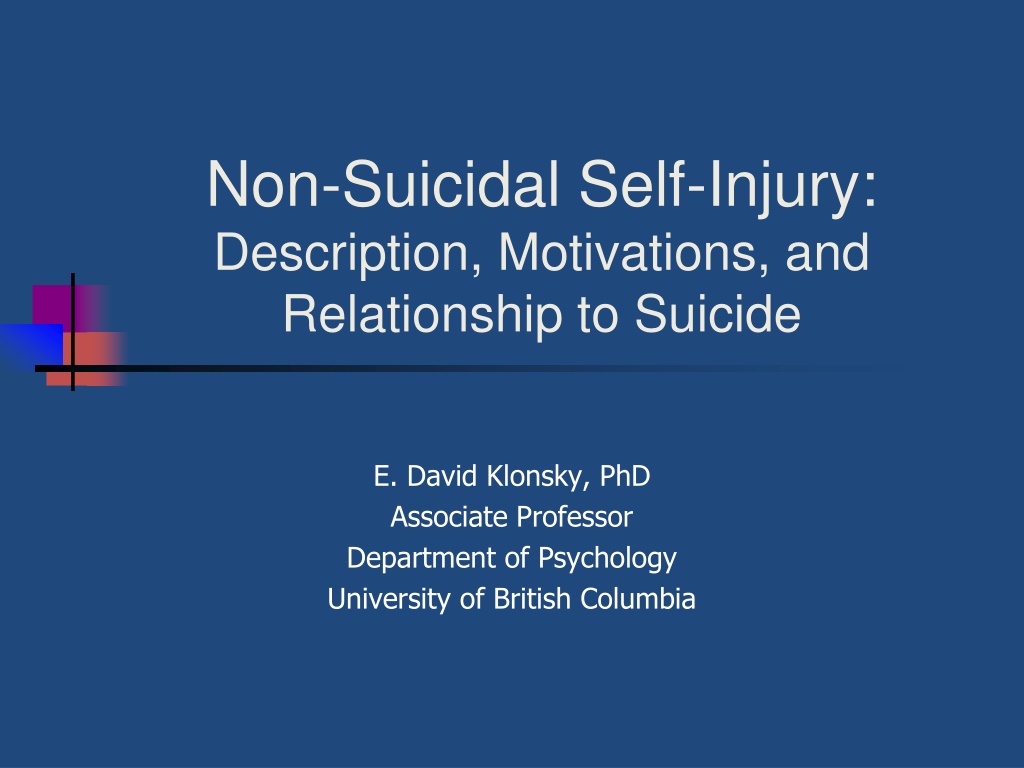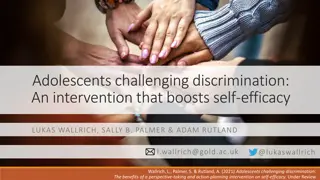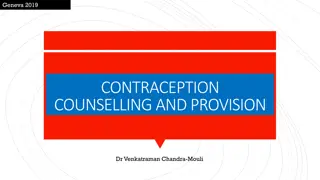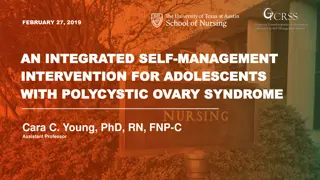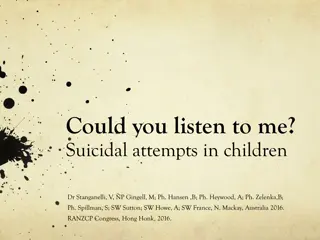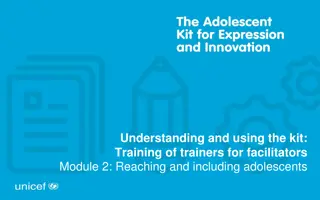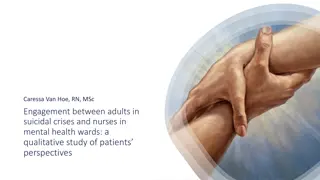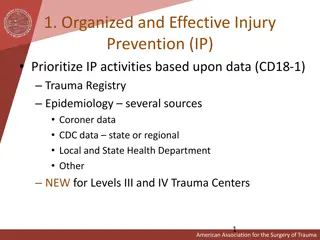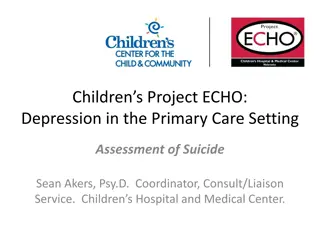Understanding Non-Suicidal Self-Injury in Youth and Adolescents
Non-Suicidal Self-Injury (NSSI) is a common issue among youth and adolescents, often misunderstood as attempted suicide. This behavior involves intentional self-harm without suicidal intent, such as cutting, burning, and scratching. It is crucial to distinguish NSSI from suicide attempts due to their different motivations and implications. Research sheds light on who engages in NSSI, why they do it, and its relationship to suicide risk.
Download Presentation

Please find below an Image/Link to download the presentation.
The content on the website is provided AS IS for your information and personal use only. It may not be sold, licensed, or shared on other websites without obtaining consent from the author. Download presentation by click this link. If you encounter any issues during the download, it is possible that the publisher has removed the file from their server.
E N D
Presentation Transcript
Non-Suicidal Self-Injury: Description, Motivations, and Relationship to Suicide E. David Klonsky, PhD Associate Professor Department of Psychology University of British Columbia
Non-Suicidal Self-Injury Common in youth and adolescents Can be confused for attempted suicide Has an important relationship to suicide risk
Agenda What is Self-Injury Who Self-Injures Why People Self-Injure Relationship to Suicide
A Preliminary Note What we know (many many studies) What we think (one or two studies) What we don t know (no research yet)
Agenda What is Self-Injury Who Self-Injures Why People Self-Injure Relationship to Suicide
What is Self-Injury? Self-inflicted damage to body tissue Intentional No suicidal intent
What is Self-Injury? Intentional, direct injuring of one s body tissue without suicidal intent Also called: non-suicidal self-injury (NSSI), self-mutilation, self-injurious behavior, self-wounding, and deliberate self-harm.
What is Self-Injury? Skin-cutting, burning, scratching, rubbing skin against rough surfaces, interfering with wound healing Does not include overdosing, eating disorder behaviors, alcohol/substance use, body piercings/tattoos*
Variation in Self-Injury Frequency Methods Medical Severity Contexts Motivations Desire/Efforts to Stop
Agenda What is Self-Injury Who Self-Injures Why People Self-Injure Relationship to Suicide
Famous Self-Injurers Princess Diana
Famous Self-Injurers Angelina Jolie
Famous Self-Injurers Christina Ricci
Famous Self-Injurers Drew Barrymore
Famous Self-Injurers Johnny Depp
Famous Self-Injurers Eminem
Famous Self-Injurers Marsha Linehan
Famous Self-Injurers Harry Potter s Dobby Klonsky, E.D. & Laptook, R. (2007). Dobby had to iron his hands, sir! Self-inflicted cuts, burns, and bruises in Harry Potter. In the Psychology of Harry Potter. BenBella Books.
Who Self-Injures? Young Adolescents 8% High-School 14 - 15% University Students 17% General Adult Population 4-6% Adolescent Inpatients 40 - 80% Klonsky, E.D. & Muehlenkamp, J.J. (2007). Self-injury: A research review for the practitioner. Journal of Clinical Psychology: In Session.
Psychological Characteristics Negative Emotions/Emotion Dysregulation Depression Anxiety Anger Self-Directed Negative Emotion Suicide Ideation and Attempts
Defining Characteristic Intense, Self-Directed Negative Emotions?
What About Abuse Histories? may be reenacting the abuse perpetrated on them (Noll, 2003) manifestation of sexual abuse (Cavanaugh, 2002) Abuse contributes heavily to the initiation of self-destructive behaviors (van der Kolk, 1991)
Child Sex Abuse and Self-Injury Analysis of 44 studies Median phi = 0.23 (small relationship) Klonsky, E.D. & Moyer, A. (2008). Childhood sexual abuse and non-suicidal self-injury: Meta- analysis. British Journal of Psychiatry.
Child Sex Abuse and Self-Injury: Conclusion Abuse histories can contribute to negative emotions driving NSSI, but many who self-injure do not have abuse histories, and many with abuse histories do not self-injure.
Agenda What is Self-Injury Who Self-Injures Why People Self-Injure Relationship to Suicide
Why People Self-Injure: Theories Theory Description of Theory Anti-Dissociation To end the experience of depersonalization or dissociation Anti-Suicide To replace or compromise with the impulse to commit suicide Emotion Regulation To alleviate intense negative emotions Interpersonal Boundaries To assert one s identity or a distinction between self and other Interpersonal Influence To seek help from or manipulate others Self Punishment To derogate or express anger towards oneself Sensation Seeking To generate excitement or exhilaration Sexual To control, distract from, or gratify uncomfortable sexual urges
Why People Self-Injure: Research Sources of evidence 1) Reasons/motivations for self-injury 2) Experience of self-injury 3) Laboratory studies of proxies for self-injury Klonsky, E.D. (2007). The functions of deliberate self-injury: A review of the evidence. Clinical Psychology Review.
Why People Self-Injure: Research Theory Evidence For Theory Anti-Dissociation R, R, R, r, r, r, P, p, -p Anti-Suicide R, r, r Emotion Regulation R, R, R, R, R, R, R, R, R, R, R, P, P, P, P, P, P, L, L, L Interpersonal Boundaries r, r Interpersonal Influence R, r, r, r, r, r, r, p, p Self Punishment R, R, R, R, R, R, r, r, r, r, r Sensation Seeking r, r, r, r, r Results of 18 studies of reasons [R, r], self-report of phenomenology [P, p], or laboratory data [L, l].
Why People Self-Injure: Research Primary sources of evidence 1) Reasons/motivations for self-injury 2) Experience of self-injury Klonsky, E.D. (2007). The functions of deliberate self-injury: A review of the evidence. Clinical Psychology Review.
Why People Self-Injure: Research Primary sources of evidence 1) Reasons/motivations for self-injury 2) Experience of self-injury Klonsky, E.D. (2007). The functions of deliberate self-injury: A review of the evidence. Clinical Psychology Review.
Emotion Regulation 50-95% of self-injurers To release emotional pressure that builds up inside me To get rid of intolerable emotions To control how I am feeling Klonsky, E.D. (2007). The functions of deliberate self-injury: A review of the evidence. Clinical Psychology Review.
Self-Punishment More than 50% of self-injurers To express anger at myself To punish myself Klonsky, E.D. (2007). The functions of deliberate self-injury: A review of the evidence. Clinical Psychology Review.
Anti-Suicide 3rdmost common reason To avoid the impulse to attempt suicide To stop suicidal ideation or attempts To stop me from killing myself Klonsky, E.D. (2007). The functions of deliberate self-injury: A review of the evidence. Clinical Psychology Review.
Anti-Dissociation/Depersonalization 4rdmost common reason To know I am capable of feeling physical pain To feel like myself again To feel real Klonsky, E.D. (2007). The functions of deliberate self-injury: A review of the evidence. Clinical Psychology Review.
Interpersonal Influence 5thmost common reason To let others know what I am going through To get those around me to understand what I m going through To get reactions out of people Klonsky, E.D. (2007). The functions of deliberate self-injury: A review of the evidence. Clinical Psychology Review.
Sensation/Excitement Seeking 6thmost common reason To feel exhilarated I thought it would be fun Klonsky, E.D. (2007). The functions of deliberate self-injury: A review of the evidence. Clinical Psychology Review.
Why People Self-Injure: Research Primary sources of evidence 1) Reasons/motivations for self-injury 2) Experience of self-injury Klonsky, E.D. (2007). The functions of deliberate self-injury: A review of the evidence. Clinical Psychology Review.
Why People Self-Injure: Research Primary sources of evidence 1) Reasons/motivations for self-injury 2) Experience of self-injury Klonsky, E.D. (2007). The functions of deliberate self-injury: A review of the evidence. Clinical Psychology Review.
Emotions and Self-Injury 40 Emotions Before, During, and After Self-Injury Examples: Angry, Sad, Lonely, Frustrated, Worthless, Guilty Happy, Relieved, Hopeful, Satisfied Bored, Restless, Apathetic Unreal, Mesmerized, In a Trance Klonsky, E.D. (2009). The functions of self-injury in young adults who cut themselves: Clarifying the evidence for affect-regulation. Psychiatry Research.
Emotions and Self-Injury Before Overwhelmed Sad Hurt Emotionally During Angry at Self Hurt Emotionally Isolated After Relieved Angry at Self Calm
Low-Arousal Negative Emotions "Sad" "Lonely" 5 4 3.5 2.9 3 3.0 2.9 2 1 Before After
High-Arousal Negative Emotions "Overwhelmed" "Anxious" 5 4 3.6 3.6 3 2.4 2.5 2 1 Before After
Low-Arousal Positive Emotions Relieved Calm 5 4 3.3 2.9 3 2 1.5 1.1 1 Before After
Big Changes in Negative Arousal Emotion Cohen s d Relieved +2.25 Calm +1.39 Overwhelmed - 0.89 Anxious - 0.81
Why People Self-Injure: Theories Theory Description of Theory Anti-Dissociation To end the experience of depersonalization or dissociation Anti-Suicide To replace or compromise with the impulse to commit suicide Emotion Regulation To alleviate intense negative emotions Interpersonal Boundaries To assert one s identity or a distinction between self and other Interpersonal Influence To seek help from or manipulate others Self Punishment To derogate or express anger towards oneself Sensation Seeking To generate excitement or exhilaration Sexual To control, distract from, or gratify uncomfortable sexual urges
Why People Self-Injure: Theories Theory Description of Theory Anti-Dissociation To end the experience of depersonalization or dissociation Anti-Suicide To replace or compromise with the impulse to commit suicide Emotion Regulation To alleviate intense negative emotions Interpersonal Boundaries To assert one s identity or a distinction between self and other Interpersonal Influence To seek help from or manipulate others Self Punishment To derogate or express anger towards oneself Sensation Seeking To generate excitement or exhilaration Sexual To control, distract from, or gratify uncomfortable sexual urges
Why People Self-Injure: Theories Theory Description of Theory Anti-Dissociation To end the experience of depersonalization or dissociation Anti-Suicide To replace or compromise with the impulse to commit suicide Emotion Regulation To alleviate intense negative arousal Interpersonal Boundaries To assert one s identity or a distinction between self and other Interpersonal Influence To seek help from or manipulate others Self Punishment To derogate or express anger towards oneself Sensation Seeking To generate excitement or exhilaration Sexual To control, distract from, or gratify uncomfortable sexual urges
Why People Self-Injure: Theories Theory Description of Theory Anti-Dissociation To end the experience of depersonalization or dissociation Anti-Suicide To replace or compromise with the impulse to commit suicide Emotion Regulation To alleviate intense negative arousal Interpersonal Boundaries To assert one s identity or a distinction between self and other Interpersonal Influence To seek help from or manipulate others Self Punishment To derogate or express anger towards oneself Sensation Seeking To generate excitement or exhilaration Sexual To control, distract from, or gratify uncomfortable sexual urges
Functions of Self-Injury Organizing conceptual framework 1. Valid and comprehensive assessment 2.
Inventory of Statements about Self-injury (ISAS) Assesses 13 functions of NSSI Three items per function 39-item measure Klonsky, E.D. & Olino. T.O. (2008). Identifying clinically distinct subgroups of self-injurers among young adults: A latent class analysis. Journal of Consulting and Clinical Psychology. Klonsky, E.D. & Glenn, C.R. (2009). Assessing the functions of non-suicidal self-injury: Psychometric properties of the Inventory of Statements About Self-injury (ISAS). Journal of Psychopathology and Behavioral Assessment.
